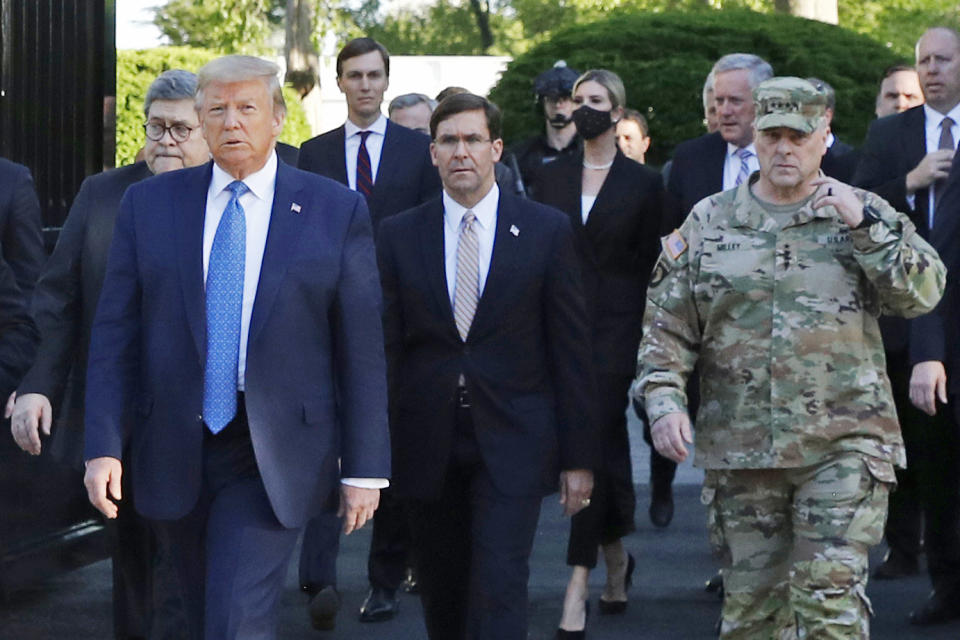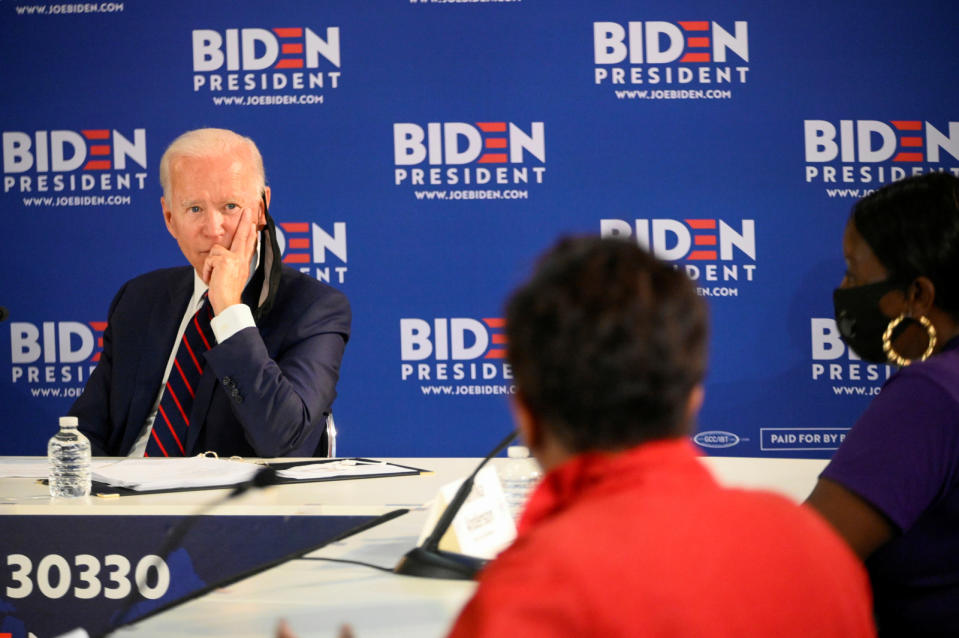St. John's Church photo may be a lasting image for Trump, but not in the way he intended
WASHINGTON — President Trump has always understood the power of images, and it was that instinct for symbolism that led him to stand in front of St. John’s Episcopal Church, across from the White House, on June 1, holding a Bible aloft, as tear gas that had been used on protesters moments earlier wafted through the air.
The former reality TV star, who was also executive producer of “The Apprentice,” intended the moment to project strength and control after a weekend when violence and looting had marred and sometimes overshadowed peaceful protests over the killing of George Floyd.
“I think it was a beautiful picture,” Trump said Friday morning in a Fox News interview. “I’ll tell you, I think Christians think it was a beautiful picture.”
But judging from the reactions of military leaders, members of his own administration and a number of new polls, Trump’s gambit has come to represent how many Americans have come to see him as a divisive rather than a unifying leader.
On Thursday, Gen. Mark Milley, chairman of the Joint Chiefs of Staff, apologized for appearing with the president during his short walk to the historic Washington church moments after police had used violent force to clear the streets of mostly peaceful protesters outside the White House. “I should not have been there,” Milley said.

Milley said his presence in battle fatigues in that environment with the president “created a perception of the military involved in domestic politics.” Trump had given a speech from the White House Rose Garden minutes before in which he vowed to “dominate the streets” and threatened to send active-duty U.S. military troops into American cities.
Trump’s first secretary of defense, Gen. Jim Mattis, issued a scathing denunciation of the president two days after the violent crackdown on protesters and the St. John’s photo. “I have watched this week’s unfolding events, angry and appalled,” Mattis wrote. He condemned the use of National Guard troops to stage “a bizarre photo op for the elected commander-in-chief, with military leadership standing alongside.”
More than 280 former military and diplomatic leaders in the U.S. government signed a letter criticizing Trump’s threat to send active military into the streets.
Trump’s support among active U.S. military members has slipped over the course of his presidency. A Military Times poll from December showed that 50 percent have an unfavorable view of him, and 42 percent approve. That’s compared with a 37 percent disapproval rating in November 2016, when he was elected, at a time when he also had a 46 percent approval rate.
Trump’s handling of the Bible, the sacred text for Christians generally but especially for white evangelicals who are among his most loyal constituencies, added another layer of offense even to some who are loyal to him. Evangelical leader Pat Robertson was critical of Trump’s actions.
One Republican involved in the president’s reelection effort lamented his use of the Scriptures and said it was hard to watch.
Only the most unquestioning of Trump loyalists defended the photo op. “By holding up the Bible, he was showing us that it teaches that, yes, God hates racism, it’s despicable — but God also hates lawlessness,” Robert Jeffress, a Baptist minister from Dallas, told the Atlantic the next day.

Trump’s presumptive 2020 Democratic rival, former Vice President Joe Biden, said the moment demonstrated that “the president is more interested in power than in principle.”
And one Republican consultant who worked in a senior position for one of Trump’s 2016 primary rivals told Yahoo News that the St. John’s photo “will be the enduring image of his presidency.”
“That is a moment that he could have taken a step back and not made this about him. But as he does with everything, he inserted himself into the middle of the protests, and in a very ham-handed way, and as a result I think it galvanized the opposition,” said the Republican political aide.
“To the extent that there are a lot of suburban Republicans, especially well-educated women, who might have voted for him in 2016, they see stuff like that and it just repels them.”
An NBC News/Wall Street Journal poll in late May, before Floyd’s death, showed Trump losing significant support among college-educated white men and women.
Trump’s job approval number is a key indicator of his chances for reelection. Presidents seeking reelection usually receive a share of the popular vote just above that number. After almost reaching 46 percent in early April, Trump’s approval has dropped to 42 percent in the RealClearPolitics polling average, and 41 percent in the average calculated by FiveThirtyEight.
The White House and the president’s reelection campaign are trying to redirect the debate away from the moment in front of St. John’s. They want the focus to be on the fact that the violence and looting that had been building in the days leading up to June 1 subsided after that day, and they want the president to get credit.
“President Trump took decisive action to secure the streets of our nation’s capital and restore law and order,” Alyssa Farah, the White House director of communications, told Yahoo News.

A White House official told Yahoo News that the clearing of H Street in front of St. John’s “was not intended to send any message.” But Attorney General William Barr has indicated it did.
“It’s very important to use sufficient forces, law enforcement, to establish law and order in a city when you have riots running,” Barr said in a press conference last week. “The way to address it is to make sure the resources are there and that people understand the resources are there to deal with that kind of violence. And I think once that occurred, it provided an environment where things could quiet down, and they did quiet down.”
But Trump’s desire for an iconic image projecting strength — which led him to stand in front of St. John’s — has overshadowed any discussion of whether the police crackdown outside the White House had anything to do with the cessation of violence.
Nonetheless, the Trump campaign is intent on casting the president as a protector rather than a provocateur. It released a video on Wednesday that showed images of fires and fistfights on city streets, and said that Biden “fails to stand up to the radical leftists fighting to defund and abolish the police.” Biden, however, has already said he does not support defunding or abolishing the police.
The Trump ad shows Biden taking a knee, but even that image is tied back to the photo of Trump in front of St. John’s, because both were taken the same day. And hours before police charged and gassed protesters to create space for the president to walk to the church, Biden sat with African-American leaders inside Bethel African Methodist Episcopal Church in Wilmington, Del., listening to their concerns. He then took a photo with the group while kneeling to show support.

The Trump campaign ad took the image of Biden with black leaders and said he was “kneeling to the left” and that this will lead to “chaos in the streets.” Trump, the ad says, “is keeping our communities safe.”
If Trump’s “law and order” message does help him get reelected, it’s possible the St. John’s spectacle will be viewed as having helped him because he took a decisive stand against protesters he has called “radical leftists.” But another challenge for him is that the country’s attitudes on race appear at the moment to be shifting dramatically in a way that puts him at a disadvantage.
Nearly two-thirds of Americans in a Yahoo News/YouGov poll conducted June 9 and 10 said systemic racism is a problem in America. Support for the Black Lives Matter movement was at 57 percent, up from 27 percent four years ago. A New York Times survey found that support for Black Lives Matter had jumped 9 points in just two weeks.
A Monmouth poll released June 2 showed similar movement during the past few years. A majority of 57 percent said they believe police are more likely to use excessive force against African-Americans, up from 33 percent six years ago.
And the Yahoo/YouGov survey found that the protests over Floyd’s killing have also sparked a huge shift in how the public sees protests carried out by former NFL quarterback Colin Kaepernick, who took a knee during the national anthem before games in the fall of 2016 to draw attention to police brutality against African-Americans.
More than half of those surveyed, 52 percent, said it is “OK for NFL players to kneel during the national anthem to protest police killings of African-Americans,” compared with 36 percent who said it is not OK.
That’s a big change from 2016, when only 28 percent of Americans surveyed said they supported Kaepernick, and from 2018, when there was only 35 percent support.
Notably, the Trump ad released Wednesday made a direct reference to the Kaepernick protests, though it did not mention the ex-player by name. The ad says Trump is “always standing for our flag.” In 2017, Trump said NFL team owners should “get that son of a bitch off the field” if a player knelt during the national anthem.
As for Trump’s favorite phrase of late, only 36 percent of Americans said they agree with him that “law and order” would help matters, according to the Yahoo News/YouGov poll. The remainder (64 percent) prefer an approach that involves “bringing people together.”
Trump has also hurt himself badly on the issue of leadership. Mattis said in his statement that the president “does not try to unify the American people” but instead “tries to divide us,” and 60 percent of those surveyed agreed. Only 15 percent say Trump’s response to the protests has been helpful.
A Washington Post/Schar School survey found 61 percent disapproval of Trump’s handling of protests against Floyd’s killing, and only 35 percent approval.
A Republican consultant working on a Senate race in a battleground state told Yahoo News that the independent voters who are key to Trump’s reelection have come to the conclusion that he “makes every situation worse.”
“He doesn’t lead. The things he needs to be doing, he can’t do,” the consultant said. “This whole election is a referendum on Trump’s leadership.”
_____
Read more from Yahoo News:



